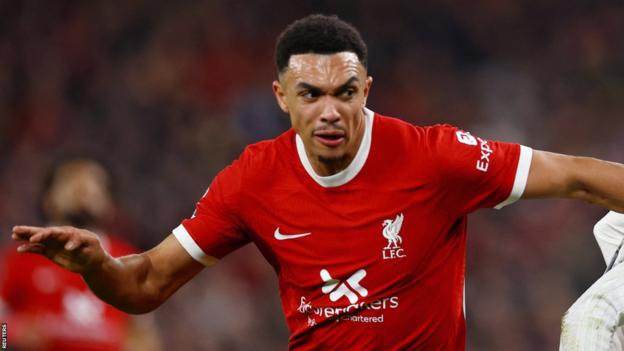The full-back is arguably the position that has evolved the most in football in the past decade.
Historically, full-backs have been positioned as the widest members of a back four and tasked with being strong in their one-v-one defensive duels against the opposition winger and providing overlapping support to their own winger – an ‘up-and-down’ type of role.
However, there has been an increasing demand on what full-backs do in possession of the ball, both during build-up play in their own half and also contributing to attacking patterns in the final third.
Look at John Stones, Oleksandr Zinchenko and Trent Alexander-Arnold – the role of full-back has changed unrecognisably from the days of Gary Neville and Ashley Cole marshalling the flanks.
Former Germany and Bayern Munich full-back Philipp Lahm was one of the first players to be used as an ‘inverted full-back’, as then manager Pep Guardiola pioneered the trend in 2013.
Lahm, who won 21 major trophies at Bayern – including the Champions League – and the World Cup, helps us look at the rise of the modern-day full-back.
‘Pep was always trying to create new opportunities’
An inverted full-back refers to coaches altering the positioning of a full-back when their team have possession, so they are playing centrally as part of the midfield unit.
Spaniard Guardiola was a pioneer of this trend at Bayern. He inverted Lahm from right-back into midfield and he even switched him to a midfield role, such was his fluent adaptation to playing in central areas.
“At the beginning of the 2000s this position was interpreted much differently, in some cases much more defensively,” says Lahm.
“In forward play, it was all about orientating yourself on the touchline and crossing. Gradually, this position has changed due to the influence of coaches such as Pep Guardiola. The role of the full-back is now more variable and also more impactful for the team. The role has taken on a new meaning.
“When defending, it’s about making as little space as possible for the opponent, taking up a lot of space and occupying it. When attacking, it’s about utilising the space, creating as much space and as many opportunities for others as possible. And Pep was always trying to create new opportunities.”
These new opportunities arise because it allows coaches to gain numerical superiority over the opposition by providing an extra body in midfield during the build-up. For instance, moving a full-back inside transforms a three-man midfield within a 4-3-3 into a four-man midfield in a shape which resembles a 3-2-2-3.
‘Zinchenko challenged by Arteta’
Although the overall positioning is similar, coaches are now employing inverted full-backs with different intentions.
Arsenal manager Mikel Arteta commonly inverts Zinchenko from left-back next to their defensive midfielder so he can use the Ukrainian’s excellent weight and accuracy of passing to progress the ball into the final third with short line-breaking passes.
Zinchenko played 27 Premier League games last season, completing the most passes (64), most passes in the opposition half (38), playing the most passes into the final third (26) and having the most touches (92) per 90 minutes of any Arsenal player.
“I like Zinchenko very much,” says Lahm. “He is a top performer and is very much challenged by Arteta.
“Interestingly, Arteta is a Spanish coach. The Spaniards are ahead of other nations. They have been playing the same football for 30 years. They have a clear philosophy.
“The coaches identify with this and pass it on to their players. As a result, the players benefit from this and continue to develop like Zinchenko.”
‘Alexander-Arnold can influence in many different ways’
Liverpool manager Jurgen Klopp has inverted Trent Alexander-Arnold from right-back into midfield since April, when they drew 2-2 with Arsenal.
However, the intention of inverting Alexander-Arnold is very different to that of inverting Zinchenko. Klopp’s objective is to get his chief creative passer into more central areas so he has a wider range of angles from which to make his trademark long passes.
A striking example of this was when Aston Villa’s high defensive line (they have caught the opposition offside more than any other Premier League team since Unai Emery was appointed) malfunctioned in a 3-0 loss at Anfield as Alexander-Arnold moved centrally and launched long passes over the top to quick runners like Darwin Nunez and Mohamed Salah.

Liverpool have played 27 league games since Alexander-Arnold started inverting into midfield and have racked up 62 points, more than any other team during that period.
Alexander-Arnold is also now Liverpool vice-captain and Lahm says his position change could act as a bonus for him.
“It is an advantage [for leadership] in the centre of midfield because you can follow the action better and influence it in many different ways,” says Lahm.
Postecoglou goes one step further
Ange Postecoglou has taken the tactic one step further by inverting both Tottenham full-backs into midfield.
One objective of this is to drag both opposition wingers inside as they attempt to press his full-backs, which subsequently opens up the passing lanes to his own wingers.
The inverted full-backs also provide his defensive midfielder – most commonly Yves Bissouma – with short passing options to play through the opposition’s second line of pressure.
Generating this numerical superiority in midfield has allowed Spurs to dominate more of the ball.
They are ranked fourth in the league this season for average possession with 59%, compared to ninth last season with 50% under Antonio Conte, when they played a more counter-attacking style with the wing-backs rigidly positioned on the touchlines in a 3-4-3.
‘A mental quickness is required’
The often overlooked aspect of inverting a full-back is how it affects the defensive side of their game.
If the possession sequence breaks down and the opposition regain the ball, the full-back finds themselves having to defend larger central spaces. Performing this role well is key to preventing dangerous counter-attacks.
Lahm says: “A certain amount of mental quickness is required. It’s always about anticipating match situations and ball movements. This anticipation is very important.
“It’s a permanent process: anticipate, stop, anticipate again. How quickly does he instinctively recognise the situation? At this level, there is almost no time to actually think.
“I played on the left side of defence, then on the right. I was therefore used to re-thinking and acting and reacting quickly. And I certainly had some form of match intelligence. At least that’s what Pep said he recognised in me for the role.”
Guardiola has made a further tweak this season and is now pushing one of his centre-backs – Manuel Akanji or Stones – into midfield.
The advantage of this compared to inverting a full-back is that it is a shorter sprint for a centre-back to change position between the defensive and build-up phase.
Furthermore, it leaves a more naturally defensive player – a centre-back – to prevent counter-attacks through the middle if the ball is lost.
The era of full-backs being viewed solely as supporting acts is long gone. Now even the elite teams are shaping their tactical identities around them.

Olivia Martin is a dedicated sports journalist based in the UK. With a passion for various athletic disciplines, she covers everything from major league championships to local sports events, delivering up-to-the-minute updates and in-depth analysis.








